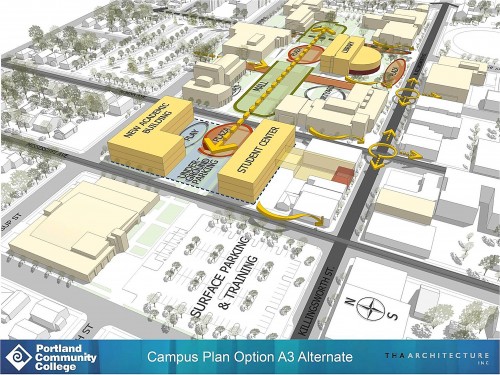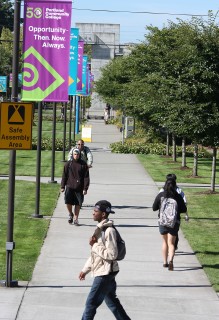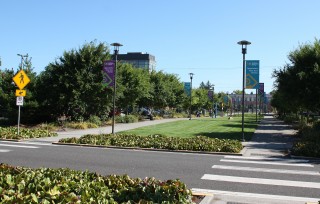This content was published: January 10, 2012. Phone numbers, email addresses, and other information may have changed.
Community input guides Cascade Campus bond projects
Photos and story by James Hill
The future vision of Portland Community College’s Cascade Campus is coming into focus.
Thanks to input from college and community members via stakeholder meetings and public outreach, decisions have been made for future development of the campus (705 N. Killingsworth St.) for new academic and parking facilities. The new Cascade Campus academic building will be located on surface Parking Lot 4 (located between Albina and Mississippi avenues at the west end of the campus). In addition, a new student center – incorporating expanded student activities and food services – will be built to the south of this building. The Cascade library will remain at its current location facing North Killingsworth Street.

The future layout for the new academic building, student center and underground parking at the Cascade Campus, near North Killingsworth.
These projects are part of the 2008 voter-approved bond measure. Approximately $60 million of the $374 million bond will support improvements at the Cascade Campus. The Cascade bond and design teams plan to begin schematic design this month. Design, city review and permitting, and development of construction documents will all take place during 2012, with construction slated to begin around this time next year (January 2013). THA Architecture is providing planning and design services for the campus.
“The way PCC reached out to the community for input far exceeded my expectations,” said Kerri Melda, a 17-year Commercial Street resident and a consultant with Human Services Research Institute. “They brought in business owners, residents, and different parts of the PCC community to have this plan go forward. It was so inclusive.”
PCC plans sculpted by community input
Before any new buildings could be built, the college needed to take the time to plan and involve many internal and external stakeholders as well as complete a campus plan. For more than a year faculty, staff, students and members of the extended neighborhood community have participated in two planning committees, which worked on parallel issues that have helped guide the decision to locate these future facilities.
“I’d like to thank the many people in and around the Cascade Campus community who have been working tirelessly volunteering time to help the campus plan for the future,” said Algie Gatewood, Cascade Campus president. “The campus has seen unprecedented growth over the past several years. Today, we serve more than 22,000 students per year, which translates to about 27 percent more students than when the 2008 bond measure was approved by voters.
“These are exciting times for the Cascade Campus community, and there will be many more discussions and opportunities to get involved as we design and build the Cascade Campus of the future,” Gatewood added.
When the bond passed in 2008, the Cascade Campus plans included more classrooms and labs, updated equipment and technology infrastructure, expanded career programming, a new child development center, improvements to the library and student services, and a parking solution to address parking demand and reduce impacts to the surrounding community.
“The addition of classroom space in the new academic building, meeting space in the new student center, and improvements in the library, will allow us to better serve more students as well as community members,” said Scott Huff, Cascade Campus dean of Instruction. “In particular, added classrooms will allow us to handle the greatly increased student numbers seen over the last several years as more students turn to PCC for their educational needs.”
Parking solution fits into college’s transportation planning
With that growth comes the issue of increased traffic to the campus and a condition to adding new square footage to the campus is to also provide adequate parking. After months of analysis, discussion and debate, the college has decided to go forward with the plan to build an underground parking garage to accompany construction of the two new campus buildings. The underground lot will provide 220 parking spaces – a net increase of about 75 spaces.

The mall area will have a new look by 2013. For more than a year faculty, staff, students and members of the extended neighborhood community have participated in two planning committees, which worked on planning.
Gatewood said in selecting the underground parking option over an above-ground option, the campus weighed cost; benefit to the community; safety, security and operational issues; efficient use of land; opportunities for future campus development; and impacts to the adjacent North Killingsworth business corridor. Building below ground parking between the two new buildings helps the campus preserve a full city block for future development and maintain the character and aesthetics of the neighborhood, he added.
The parking decision fits well into the college’s current Transportation Demand Management (TDM) initiative, where PCC and community representatives are working with several expert transportation consultants to help identify a wide range of alternative transportation strategies for the entire PCC district. These include a reduction in the reliance on single-occupant cars, help meet the goals of the college’s Climate Action Plan and maintain access to education.
Gatewood said the future is bright on this front because Cascade has more people choosing alternative modes of transportation – biking, walking, ridesharing, public transit and PCC shuttles – than any other PCC facility (for instance, ten percent of campus commuters are bike riders, highest at any location).
“Our location makes us an ideal candidate for alternative transportation,” Gatewood said. “Both the parking options that were under final consideration would have required advancing incentives to use alternate transportation modes, such as bike amenities, transit subsidies, pricing and operational adjustments and more. I believe we are up to the challenge.”

